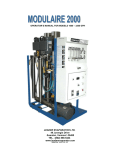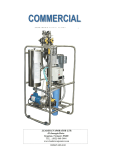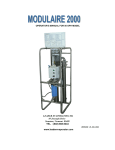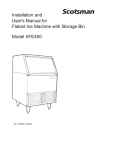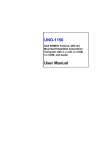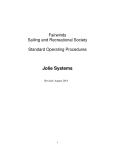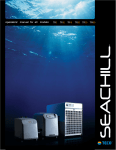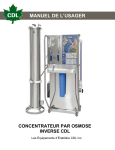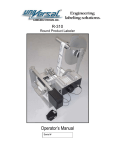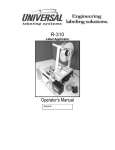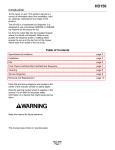Download mode d`emploi des concentrateurs modulaire 2000
Transcript
OPERATOR’S MANUAL FOR MODEL 500-1000 GPH LEADER EVAPORATOR LTD. 49 Jonergin Drive Swanton, Vermont 05488 (802) 868-5444 www.leaderevaporator.com VERSION 2005-02-02 OPERATOR’S MANUAL FOR A REVERSE OSMOSIS 2000 TABLE OF CONTENTS________________________ 1. MODULAIRE 2000 USER’S MANUEL...................................................... 5 1.1 INTRODUCTION ....................................................................................... 5 1.2 BACKGROUND.......................................................................................... 5 1.3 OPERATION ............................................................................................... 5 1.4 INSTALLATION : .................................................................................... 11 2. YEARLY START UP................................................................................... 12 3. USER’S GUIDE ............................................................................................ 13 3.1 GUIDE FOR 1HP PUMP.......................................................................... 13 3.2 GUIDE FOR 3HP PUMP.......................................................................... 15 3.3 CALCULATION OF SAP CONCENTRATION % .............................. 17 3.4 MEMBRANE PERMEABILITY TEST ................................................. 18 3.5 ANNUAL CLOSING PROCESS ............................................................. 19 3.6 PRESERVATION SOLUTIION.............................................................. 20 3.7 ANNUAL STORAGE PROCESS ............................................................ 20 4. MANUFACTURER WARRANTY ............................................................ 20 5. EQUIPEMENT DESCRIPTION ................................................................ 22 5.1 PHYSICAL DIMENSIONS...................................................................... 22 5.2 PRE-FILTER ............................................................................................. 24 5.3 PRESSURE PUMP.................................................................................... 25 5.4 MEMBRANE CASING ............................................................................ 26 5.5 READING PANEL.................................................................................... 27 5.6 ELECTRICAL BOARD ........................................................................... 28 5.7 OPERATION DATA.................................................................................. 29 APPENDIX 1. SERIAL EXPANSION KIT AND EXPANSION MODULE39 APPENDIX 2. PIPE INSTALLATION SUGGESTIONS………………..40 2 LIST OF FIGURES___ _____________________________ FIGURE 1. OSMOSIS AND REVERSE OSMOSIS ......................................................... 4 FIGURE 2. FUNCTIONING OF THE 600 GAL REVERSE OSMOSIS .............................. 6 FIGURE 2. SERIAL FUNCTIONING WITH EXPANSION KIT (SEE APPENDIX 1)*…………. 6 FIGURE 3. FEEDING PUMP 1HP (P7) ...................................................................... 7 FIGURE 4 . TEMPERATURE CONTROLLER (S8) ...................................................... 7 FIGURE 5. PRE-FILTER ........................................................................................... 8 FIGURE 6. PRESSURE CONTROL (C11) ................................................................... 8 FIGURE 7. MEMBRANE (M5) .................................................................................. 9 FIGURE 8. FILTER ................................................................................................. 11 FIGURE 9. COUPLING TABLE ................................................................................ 11 FIGURE 10. PICTOGRAM....................................................................................... 16 FIGURE 11. DATA RESULTS .................................................................................. 17 FIGURE 12. REVERSE OSMOSIS UNIT .................................................................... 23 FIGURE 13. PRE-FILTER (10 MICRONS) ............................................................... 24 FIGURE 14. PRESSURE PUMP ................................................................................ 25 FIGURE 15. MEMBRANE HOUSING ....................................................................... 26 FIGURE 16. READING PANNEL .............................................................................. 27 FIGURE 17.ELECTRICAL BOARD FOR 600 GAL .................................................... 28 FIGURE 18. OPERATION DATA.............................................................................. 29 FIGURE 19. PRODUCTION SHEET FOR REVERSE OSMOSIS ................................... 36 FIGURE 20. CORRECTION FACTOR SHEET ........................................................... 38 FIGURE 21. SERIAL AND PARALLEL FUNCTIONING.............................................. 39 FIGURE 22 : SERIAL EXPANSION KIT 8” X 40” .................................................... 41 FIGURE 23. INSTALLATION DIAGRAM (1) ............................................................ 43 FIGURE 24. INSTALLATION DIAGRAM (2) ............................................................ 43 FIGURE 25. VALVES .............................................................................................. 44 3 Figure 1. Osmosis and reverse osmosis 4 1. MODULAIRE 2000 USER’S MANUEL CONGRATULATIONS! You just acquired an LEADER reverse osmosis. This proves your interest in new technologies and beautiful things. In fact, you have purchased a technologically advanced unit built by skilled professionals at LEADER EVAPORATOR LTD., who bring many years of research to the use of reverse osmosis in maple syrup production. 1.1 INTRODUCTION Reverse osmosis is a process by which a solution’s natural tendency to scatter its components uniformly is reversed. It occurs in the reverse osmosis because an applied pressure forces the water through a semi-permeable membrane. The water that does not pass through the membrane is left with all the sugar and thus called the concentrate. 1.2 BACKGROUND The reverse osmosis process has been observed and studied for more than 250 years. Father Nolet, a French scientist, carried out experiments on the osmosis phenomenon around 1748. The scientists have realized long ago that this process could be reversed and that many applications could flow from this research. The principle of reverse osmosis has been applied to the desalination of water since the beginning of 1960. 1.3 OPERATION How does it work? This is probably the first question that came to your mind as you opened this manual. The sap provided by maple trees is a solution containing mostly water (96% to 98%), 2% to 3% sugar and small quantities of mineral salts, proteins and other elements such as aroma. Sap is the solution in which you will increase the amount of sugar in relation to the quantity of water. This will be done by extracting the water from the maple tree sap. This separation process will give a more concentrated sap solution (concentrate) and the portion of water which has been subtracted from the sap (permeate). 5 Figure 2a. Functioning of the 600 gallons. reverse osmosis Figure 2b. Functioning with serial expansion kit (see appendix 1)* *Even if certain components appear in different quantities, the functioning of the 500 gal to 1000 gal reverse osmosis is the same. 6 V6 : Inlet valve Three basins (washing, permeate and sap) are connected to this three-way valve, located at the machine inlet. The origin of the liquid entering the reverse osmosis unit is determined by the valve’s position. V6 B20: Wash basin This basin, located above the feeding pump, stores the washing liquid. *The soap and recirculation washes are explained in the USER’S GUIDE section. Figure 3. Feeding pump 1HP (P7) P7 : Feeding pump All of the liquid entering your machine – sap, washing liquid or permeate – goes through the feeding pump that gives it the impulse necessary to pursue its way inside the reverse osmosis. Sap and permeate basins The sap basin contains the maple tree sap. The permeate basin is filled with the water extracted from the sap during the concentration procedure. We recommend that the sap and permeate basins be connected with a common feeding pipe connected directly to the inlet valve (V6) of your machine. We also recommend that the permeate basin be able to contain at least twice the modulaire’s capacity. It is preferable to place the maple sap and permeate basins in such a way that gravity will cause the liquids to run. By doing this you will not have to provide your machine with an additional pump pushing the fluids up to the valve V6. Please note that the sap and permeate basins are not supplied by the company. Sap and permeate pipes Return lines have to be installed up to the permeate and concentrate basins. These lines must be emptied. Here is a suggestion that will help you to succeed. Place the V19 valve in rinse position, V3 and V4 valves half-way between two positions at a 45 degree angle. The position of the V6 and V18 valves is not important. This will send all liquid in the pipes to the drain. You must be able to get these lines out of the basins so that the liquid contained in those basins is not drained during the process. By following the paragraph below, it will possible to wash the sugar residue from the concentration pipe. Here is a way of doing it. First of all, make sure to install the pipe in a drain or a basin that can be emptied. At the end of the RO wash, put V4 valve in concentration position. This will send the hot water from the wash into the concentrate pipe instead of the drain. Repeat this procedure in rinse mode. (To do this operation close the valve V18 partially). Sap and permeate basin valves The flow of those basins must be controlled by a valve situated under each one. Figure 4 . Temperature controller (S8) S8 7 S8 : Temperature controller This controller evaluates the liquid’s temperature as it penetrates the reverse osmosis. The value is immediately displayed on a screen located on the reading panel. The temperature must never exceed 49o Celsius (120o Fahrenheit). The programming manual is available inside the reading panel. J28: Pressure Gauge This gauge measures the pressure provided at the feeding pump. Its value is indicated on the reading panel. F9 : Pre-filter The sap is filtered by a 10 micron cartridge. This clears it from any substance in suspension. F9 Figure 5. Pre-filter C11 : Low Pressure control This control ensures that the filters are not obstructed by dirt or micro-organisms. If such were the case, the machine would stop by itself, thus protecting the pumps and membranes. Figure 6. Pressure control (C11) C11 J10 : Pressure gauge This gauge allows you to read the pressure at the filters’ outlet. Should it drop below 12 psi (82,737kPa), the machine will stop by itself. P12 : Pressure pump The filtered water is pressurized with the help of the pressure pump. The lower part of the pump creates what is called recirculation. This gives the sap the necessary speed to clean the membrane surface automatically during the sap concentration process. The same thing happens to the washing liquid during the soap and recirculation washes. M5 M5 : Membrane The sap is concentrated by the membranes resulting in a sweeter sap (concentrate) and treated water (permeate). It is possible to add a serial expansion kit to increase your reverse osmosis capacity (see appendix 1). V2 : Concentrate flow regulating valve As it comes out of the membrane, the concentrate sets out for the reading panel, reaching a flow regulating valve. The flow will be measured by a flowmeter (D24). You can adjust the concentration percentage by regulating the concentrate flow. The sample valve V32 will allow you to determine the concentration that suits you. 8 Figure 7. Membrane (M5) D24 : Concentrate flowmeter This flowmeter calculates the concentrate flow. The value, in gallons per minute (GPM), is indicated on the reading panel D23 : Permeate flowmeter As it comes out of the membrane, the permeate is run directly through this flowmeter. The flow value is indicated on the reading panel in GPM. During the concentration process, the liquid is directed to the permeate storage basin. It is essential to know the permeate and concentrate flows to calculate the sap concentration percentage. This calculation is detailed in section 3.1 CALCULATION OF THE SAP CONCENTRATION %. V1 : Concentrate pressure regulating valve This valve controls the concentrate pressure. The pressure increases as you tighten the valve and decreases as you loosen it. J29: Pressure gauge (membrane pressure) It is this gauge which evaluates the concentrate pressure in the membrane. It is possible for you to know the value of this pressure (in psi.) simply by looking on the reading panel. V31 Permeate sample valve This valve is located at the machine outlet, more precisely on the manifold near the V3 and V4 valves. You can know if the reverse osmosis process is performed correctly by analyzing the permeate. For example, if the membrane is damaged and therefore not able to retain all the sugar, your permeate will be sweet. V32 Concentrate sample valve Located at the machine outlet, after the V4 valve, this valve allows you to obtain a concentrate sample before it is sent into the concentrate basin. With this sample you will be able to note the difference made by a change of the concentrate flow on the concentration percentage and therefore you will be able to obtain the sweetness you want. Concentrate basin After going through the valves, flowmeters and gauges, the concentrate is directed to a storage basin (concentrate basin) to feed the evaporator. The company does not provide you with this basin. V3 : Permeate direction valve V4 : Concentrate direction valve The direction taken by the liquid is determined by the three-way valve position. The black arrows indicate which ways the permeate (V3) and the concentrate (V4) can go. V18 : Drain valve This valve is closed during the concentration process. It is open while washing or rinsing. V19 : Direction valve This valve directs the water during washing or rinsing only. MANUAL OPERATING : When selecting this operating mode, you choose the starting time of your machine. The feeding pump sill start first and then, pressure pumps will start sequentially. 9 AUTOMATIC OPERATING: In the automatic operating mode, the machine can start automatically when the sap basin is full and stop by itself when it is empty. Manual adjustments have to be made first. TIMER: By setting the timer, you choose your RO’s operating duration. You will find an image accompanied by a short description of the reading panel in section 5.5. The selector (# 11) is used for the manual and automatic operating. The position of the washing timer (#2) is also shown on this page. 10 1.4 INSTALLATION : All the Leader Evaporator modulaires are delivered with three-way valves at the inlet and outlet of the machine. The permeate and sap basin pipe ought to be connected to a filter (figure 8). The latter must be connected to the V6 valve if this is not already done when you receive your machine. The pipe diameter has to be equal to or greater than that of the filter installed on the machine (see table below). You must plan your connecting pipes to prevent restriction during the rinse and concentration cycles. Watertightness of the feeding pipe must be checked to prevent vibrations which could cause pressure pump and membrane deterioration. The table below shows the coupling dimensions. Valve allowing the relief of the air in the pipes. Figure 8. Filter V6 Valve Connect the sap and permeate pipe to this end. This part can be unscrewed to clean the filter inside.* Capacity, # model Input 80 -160 (GPH) 1’’ LYNX 1½’’ 150 – 600 (GPH) Modular 2000 1½’’ 600 – 1000 (GPH) Modular 2000 2’’ plus 10 Brix 1600 (GPH) 3’’ Modular 2000 2400 - 3200 (GPH) Permeate ¾’’ 1’’ Concentrate Drain ¾’’ 1’’ 1’’ 1’’ Overflow 11/2 11/2 1’’ 1’’ 1’’ 11/2 1¼’’ 1’’ 11/2’ 2 1½’’ 1¼’’ 11/2’’ 2 Figure 9. Coupling table *We suggest that you wash the filter every day you use your RO. 11 A well lit, well heated, well ventilated, isolated shelter for the machine should be planned in the saphouse. The entrance door dimensions must be calculated according to the machine dimensions (see section 5.1). The shelter should be heated prior to delivery and installation of the machine. The durability of the electrical components will depend on the feeding quality. Therefore, it is very important to have your electrician check your installations to make sure that they comply with the local electricity code standards. 2. YEARLY START UP All the following procedures can be made with spring water (without Chlorine!) or well water, as long as it is clean and does not stain. Your machine has been filled with a glycol solution to prevent the membranes and other components from freezing. The preparation of your system at the beginning of each season must be carried out in the following way: ¾ Read the user’s manual completely. ¾ Call an electrician to connect the unit to an electrical source. ¾ Connect the unit to the maple sap, concentrate and filtrate basins. ¾ Connect the filtrate pipe beneath the membrane. ¾ Plug in the machine and rinse the unit following the same process as for membrane rinsing with half the number of water gallons your unit can concentrate in an hour. For example, if your machine has an 8 inches membrane, thus a 600 gallons per hour (GPH) capacity, rinse it with 300 gallons of water. ¾ Perform a washing without soap, reaching a water temperature of 460C (1150F). ¾ Do a second rinsing cycle as soon as the washing cycle is finished. ¾ Do a second washing without soap. It is very important to reach the water temperature mentioned before. ¾ Do another rinsing cycle as soon as the washing cycle is finished. ¾ Do a third washing cycle, this time adding the soap. Make sure to reach a temperature of 460C (1150F). ¾ Do a final rinsing cycle with half the number of water gallons your unit can concentrate in an hour. ¾ Carry out a permeability test of membranes 1. Fill the washing basin just to half of its capacity with filtrate. 2. Concentrate the permeate at 200 PSI pressure. Returning the permeate and concentrate to the washing basin. To do that, you must position the valves in washing soap cycle, close valve V18 and adjust the pressure to 200 pounds. 3. Take down a reading of permeate flow when the temperature reaches 130C (550F). This reading will indicate you the filtration capacity of your membrane only without imply another factor such as temperature, biofilms or bacteria. A permeability test at 210C (700F) and 150 PSI, will give you the same lecture. 4. Compare the permeate flow value with the one taken when the unit was manufactured or after you first utilisation during the season. You will evaluate in this way the permeability of your membrane. This data will be your reference for other successive tests. ¾ You are now ready to concentrate maple sap. 12 3. USER’S GUIDE This manual was designed to help you work with your reverse osmosis. All of these instructions are also printed on the front of your machine. N.B. TO AVOID BREAKING THE UNIT, MAKE SURE THAT THE PUMPS ARE FILLED WITH WATER BEFORE STARTING THE MACHINE. 3.1 GUIDE FOR 1HP PUMP 13 14 3.2 GUIDE FOR 3HP PUMP 15 Figure 10. Pictogram 16 3.3 CALCULATION OF SAP CONCENTRATION % The concentration percentage is calculated in terms of the permeate and concentrate flows. Operation data Date 1 Example 1 Example 2 Example 3 Density (Brix) Flow (GPM) Temp. Sap Conc Permeate Conc. 2 2.0 2.0 2.0 3 8.0 5.0 4.0 4 9.0 9.0 9.0 5 3.0 6.0 9.0 F Degrees Pressu re psi Concentrate Conc %. 6 55 55 55 7 300 300 300 100x(4/(4+5)) 75% 60% 50% Conc. Flow GPH 60x(4+5) 720 900 1080 or Test C C C T Concentration calculus 30 20 10 0 Concentration calculus Concentration calculation 20 Exemple 3 Example 1 2 3 3 Exemple 2 2 Example Example Exemple 1 1 Flow (gpm) Flow (gpm) Concentration calculation 10 0 Examples 1 2 Example 3 Concentrate Concentré Permeate Filtrat Figure 11. Data results (Permeate flow) ) (Permeate flow + Concentrate flow) Hour flow = 60 x (permeate flow + concentrate flow) % = 100 x ( %Concentration of concentration Here are three examples to facilitate your comprehension: your machine treats 9 gpm of permeate and you set the concentrate at 3, 6 or 9 gpm. What will be the concentration percentage and the total flow of the machine? Let us use the data sheet above: 1) filtrate = 9gpm and concentrate= 3 gpm Concentration % = 100 x ((9)/(3+9)) = 75% @ 720 gallons per hour 2) filtrate = 9 gpm of concentrate =6 gpm 17 Concentration % = 100 x ((9)/(6+9)) =64% @ 840 gallons per hour 3) filtrate = 9 gpm and concentrate = 9 gpm Concentration % = 100 x ((9)/(9+9)) = 50% @ 1080 gallons per hour IT IS VERY IMPORTANT THAT YOU REMEMBER TO TAKE THIS DATA EVERY DAY YOU USE YOUR REVERSE OSMOSIS. THIS WILL ENABLE YOU TO DETECT ANY OPERATIONAL DIFFICULTY. 3.4 PERMEABILITY TEST OF MEMBRANES The filtration process and the membrane’s performance vary depending on the type of membrane, exerted pressure on membrane, sap temperature, percentage of sugar in the concentrate, and presence of other components such as bacteria, biofilm and mineral salts. Therefore, it is important to maintain similar test conditions for all samplings. To do so, we recommend that you use the following method: 1) Prepare a basin full of permeate obtained from sap concentration or from clear, detritus free spring water. 2) Rinse machine for 10 minutes with permeate so that only permeate remains inside. 3) Fill the washing basin just to half of its capacity with filtrate. 4) Concentrate the permeate at 200 PSI pressure. Returning the permeate and concentrate to the washing basin. To do that, you must position the valves in washing soap cycle, close valve V18 and adjust the pressure to 200 pounds. 5) Take down a reading of permeate flow when the temperature reaches 130C (550F). This reading will indicate you the filtration capacity of your membrane only without imply another factor such as temperature, biofilms, or bacteria. A permeability test at 210C (700F) and 150 PSI, will give you the same lecture. You can compare the permeate flow value with the one taken when the unit was manufactured. 6) Compare the permeate flow value from your test (no 5) to the same test made at the factory or when you operated your machine for the first time during the season. You will then be able to establish the exact condition of your membrane. 18 3.5 ANNUAL CLOSING PROCESS All of the following procedures can be made with spring water (without Chlorine!) or well water, as long as it is clean and does not stain. Use as much permeate water as possible to store your machine. 1 Rinse your machine with half the number of water gallons it can concentrate per hour. 2 Wash the machine with the amount of soap recommended and let the temperature raise up to 460C (1150F). Soap = 4 ounces per membrane. 3 Rinse your machine with half the number of water gallons it can concentrate per hour. 4 Wash the machine with ACID and let the temperature raise up to 460C (1150F). The unit should soak as long as possible (maximum 1 month). 5, 6, and 7 Do another rinse and wash soap cycle followed by another rinsing as you had done in the three first steps. Do a permeability membrane test. ¾ Fill the washing basin just to half of its capacity with filtrate. ¾ Concentrate the permeate at 200 PSI pressure. Returning the permeate and concentrate to the washing basin. To do that, you must position the valves in washing soap cycle, close valve V18 and adjust the pressure to 200 pounds. ¾ Take down a reading of permeate flow when the temperature reaches 130C (550F). This reading will indicate you the filtration capacity of your membrane only without imply another factor such as temperature, biofilms or bacteria. A permeability test at 210C (700F) and 150 PSI, will give you the same lecture. ¾ Compare the permeate flow value with the one taken when the unit was manufactured or after you first utilisation during the season. You will evaluate in this way the permeability of your membrane. 8 If your membrane is clean, continue on step # 9. If you are not satisfied with the cleanness of your membrane, you can pursue this process on step # 4 or simply send back the membrane to be CLEANED at the factory. 9 Put 20 litres of permeate in the washing basin and 4 litres of glycol or glycerine. Add a teaspoon of préserve-osmo and let the water flow for 15 minutes. Then, stop your machine and HEAT the room all year between 50C and 100C. P.S.: If the room is subject to FREEZING, put 20 litres of glycol or glycerine for each 8’’x40’’ membrane and 30 litres for each 8’’x 60’’ membrane in the wash basin and let the liquid run inside the machine (see annual storage with antifreeze). 19 3.6 ANNUAL STORAGE WITH ANTIFREEZE It is possible to further insure adequate storage of your machine by storing it in a glycol and water solution and following instructions for the soap washing process. Before carrying out the annual storage process, you must be sure that the machine has been thoroughly cleaned. 3.6.1 PRESERVATION SOLUTION This preservation solution will protect the machine against freezing during the winter months. The below table presents you the way to proceed. Quantity Description 20 liters Glycol or glycerine for one membrane 8’’ x 40’’ 30 liters Glycol or glycerine for one membrane 8’’ x 60’’ ½ ounce Of préserve-osmo Code Quantity Description 01260011 20 Liters Glycol antifreeze alimentaire 01260051 4 Liters Glycol antifreeze alimentaire 01260823 20 Liters Glycerine alimentaire 01260824 4 Liters Glycerine alimentaire Proceed in the following way: 1. Valves positioned in washing soap cycle, with the exception of valve V19 (rinsing cycle) 2. Drain the washing basin. 3. Add the preservation solution. 4. To reduce the solution in the basin to 4 inches (bottom–up). Switch position in manual operation by 15 seconds period allowing in this way, the starting of the priming pump without the action of the pressure pump. 5. Valves position in washing soap cycle. 6. Do a solution circulation for a period of 10 minutes. Following the above steps, drain the basin and the permeate output under the membrane housing 20 4. MANUFACTURER WARRANTY Reverse osmosis machines are guaranteed by their manufacturer against all workmanship defects for a period of two complete seasons, starting on the installation date of the machine. The manufacturer’s responsibility regarding this warranty is limited to the repair or replacement of parts when he should consider it necessary to do so. All replaced parts become the manufacturer’s property. Leader Evaporator Ltd shall not be held responsible for any damage or injury arising from negligence, abuse, improper handling or installation. 21 5. EQUIPEMENT DESCRIPTION Your reverse osmosis unit includes the following components : 5.1 PHYSICAL DIMENSIONS MODEL MEMBRANE CAPACITY MEMBRANE 2 FEEDING PRESSURE TOTAL DIMENSIONS PRE- GPH FT OF SURF. PUMP PUMP AMP W x DEPTH x H FILTER AE124450 2 x 150 300 150 5CV 26 AMP 29"x34"x69" 1X20" AE134450 3 x 150 450 225 5CV 26 AMP 29"x34"x69" 1X20" AE118450 1 x 600 500 400 5CV 26 AMP 29"x42"x72" 2X20" AE118475 1 x 600 600 400 7.5CV 37 AMP 29"x42"x72" 2X20" AE318475 1 x 600 600 400 7.5CV 44 AMP 29"x42"x72" 2X20" AE328475 2 x 600 1000 800 7.5CV 44 AMP 29"x42"x72" 2X20" AE5384D75 3 x 600 1600 1200 2 X 7.5CV 81 AMP 30"x73"x72" 4X20" AE5484D75 4 x 600 2000 1600 2 X 7.5CV 81 AMP 30"x86"x72" 4X20" AE118675 1 x 800 700 600 7.5CV 37 AMP 29"x42"x77" 2X20" AE318675 1 x 800 800 600 7.5CV 44 AMP 29"x42"x77" 2X20" AE518675-E2 1 x 800 800 600 7.5CV 51 À 81 30"x54"x77" 2X20" AE7518675-E3 1 x 800 800 600 1 CV/230 VOLTS 1 CV/230 VOLTS 1 CV/230 VOLTS 1 CV/230 VOLTS 3 CV/230 VOLTS 3 CV/230 VOLTS 5 CV/230 VOLTS 5 CV/230 VOLTS 1 CV/230 VOLTS 3 CV/230 VOLTS 5 CV/230 VOLTS 7.5CV/230 VOLTS 2 X 7.5CV 60 À 120 30"x73"x77" 2X20" AE5286D75 2 x 800 1600 1200 2 X 7.5CV 81 AMP 30"x54"x77" 4X20" AE75286D75E3 2 x 800 1600 1200 5 CV/230 VOLTS 7.5CV/230 VOLTS 2 X 7.5CV 90 À 120 30"x73"x77" 4X20" AE75286D75E4 2 x 800 1600 1200 7.5CV/230 VOLTS 2 X 7.5CV 90 À 150 30"x86"x77" 4X20" AE75386T75 3 x 800 2400 1800 7.5CV/230 VOLTS 3 X 7.5CV 120 AMP 30"x73"x77" 6X20" AE75386T75E4 3 x 800 2400 1800 7.5CV/230 VOLTS 3 X 7.5CV 120 À 150 30"x86"x77" 6X20" AE75486Q75 4 x 800 3200 2400 7.5 CV/230 VOLTS 4 X 7.5CV 150 AMP 30"x86"x77" 8X20" Reverse osmosis with 2nd membrane in series to concentrate at a 10 o brix level MODEL MEMBRANE CAPACITY MEMBRANE FEEDING PRESSURE AMP DIMENSIONS PRE- GPH PUMP PUMP TOTAL W x DEPTH x H FILTER AE328475B 2 x 600 1000 FT2 OF SURFACE 800 3 CV/230 VOLTS 7.5CV 64 30"x54"x77" 2X20" AE518418675B 1 x 600 1200 1000 5 CV/230 VOLTS 7.5CV 71 30"x54"x77" 2X20" 2000 2000 7.5CV/230 VOLTS 2 X 7.5CV 131 30" x 85 3/16" x 77" 4X20" 1 x 800 AE75284286D75B 2 x 600 2 x 800 The average capacity of the reverse osmosis machine is expressed in American gallons for a sap concentration of 2 to 10 degrees brix at a temperature of 550F. 22 DIMENSIONS FOR A 600 GAL UNIT Height : 72" Width : 29" Depth : 42" machine # : AE118450 See table of physical dimensions 72" 42" 29" Figure 12. Reverse osmosis unit 23 5.2 PRE-FILTER A 10 microns filter is used to clear the liquid to be treated from any substance in suspension. • length: 50 cm • diameter : 6.5 cm 50cm Figure 13. Pre-Filter (10 microns) 6.5cm 24 5.3 PRESSURE PUMP A pressure pump is used to pressurize the liquid in order to obtain the desired filtration. This pump has the following features: MOTOR PRESSURE FLOW ELECTRICITY HP PSI GPM PH VOLTS AMPS. 5 400 10 1 230 20 7.5 400 16 1 230 30 *208, 230, 440 and 600 volt three-phase engines are available upon request. Figure 14. Pressure pump 16GPM # 7 9 11 12 13 85 Number 095006 950003 095515 090012 105051 100090 Description SEAL RINGS (NBR) INT. CHAMBER SPLIT CONE NUT SPLIT CONE IMPELLER UPTHRUST WASHER 16GPM 80GPM # 7 8 9 11 12 13 72 Number 225014 120001 125005 120003 120002 125003 120005 Description SEAL RING INTERMEDIATE BEARING INTERMEDIATE CHAMBER SPLIT CONE NUT SPLIT CONE IMPELLER AND WEAR RING IMPELLER WEAR RING 80GPM 25 5.4 MEMBRANE CASING Each membrane is enclosed in a casing with the following features: • material : stainless steel • dimensions: 125 x 20 cm 01260826 ENVELOPE 5" FOR COMPLETE MEMBRANE 4" 01260119 ENVELOPPE 8 1/2" * 40" STAINLESS STEEL 01260473 ENVELOPPE 8 1/2" * 60" STAINLESS STEEL 01260019 SERIAL EXPANSION KIT 8” X 40” 600 GPH 01260439 SERIAL EXPANSION KIT 8” X 60” 800 GPH INCLUDES: - 1 MEMBRANE 8" x 40" or 8" x 60" - 1 ENVELOPE 8.5" x 40" or 8.5" x 60" stainless steel - 1 SUPPORT - TURBO PUMP 3HP stainless steel - MAGNETIC STARTER - OPTIONS 01261011 FLOWMETE KIT 10 GPMR 01261012 FLOWMETER KIT 20 GPM 01260023 EXPANSION MODULE 8" X 40" FOR RO AIRABLO INCLUDES: - MEMBRANE 8"x 40" - ENVELOPE 8.5"x 40" - STAINLESS STEEL FILTER (ENVELOPE) - COUPLING KIT 01260732 EXPANSION MODULE 8" X 60" FOR RO AIRABLO INCLUDES - MEMBRANE 8"x 60" - ENVELOPE 8.5"x 60" - STAINLESS STEEL FILTER. (HOUSING) These modules are made for EXPANSIONABLE separators. The flowmeters, pressure gauges, etc. are not included. *SEE APPENDIX ON SERIAL EXPANSION KITS AND EXPANSION MODULES Figure 15. Membrane housing 26 5.5 READING PANEL The reading panels were designed to meet your needs. They include the following items as standard equipment: 4 3 1 6 5 8 9 7 11 10 2 CODE 01090018 01090021 01090013 01150155 01260117 01260098 01260422 01260422 01151198 01150709 01153371 01150706 01153355 # 1 1 1 2 3 4 5 6 7 8 9 10 11 DESCRIPTION PRESSURE INDICATOR (0-100 PSI) PRESSURE INDICATOR (0-300 PSI) PRESSURE INDICATOR (0-1000 PSI) TIMER 0-60 MINUTES PERMEATE FLOWMETER CONCENTRATE FLOWMETER CONCENTRATE PRESSURE REGULATING VALVE V1 CONCENTRATE FLOW REGULATING VALVE V2 TEMPERATURE DISPLAY PRESSURE PUMP (clear light) FEEDING PUMP HIGH TEMPERATURE (red light) SELECTOR : MAN/ STOP/ AUTO Figure 16. Reading pannel 27 5.6 ELECTRICAL BOARD 1 4 6 5 8 7 3 11 2 16 12 13 17 15 9 10 14 # CODE QUANTITY DESCRIPTION 1 2 3 4 5 6 7 8 9 10 11 12 13 14 15 16 17 1151310 1150190 1150059 1150038 1150758 1150144 1150191 1151590 1152121 1150624 1150258 1150727 1150737 1150106 1150757 1150759 1150758 1 2 1 1 0.2 1 1 1 1 1 2 1 1 1 0.04 7 0.13 FUSE HOLDER 2 POLES 30 AMPS 600 VOLTS FUSE 4.0 AMPS 250 VOLTS RELAY BASE 11 PINS (OMRON) (DANFOSS) MULTI MODE TIMER 120/240 V 1.2 SEC TO 300 HRS 1 METER DIN RAIL 1 1/4" FOR ELECTRICITY ELECTROD CONTROL SYRELEC PNR 220A RELAY BASE 8 PINS (OMRON) BARRIER TERMINAL 300V 12 TERMINALS 6.0" LONG MODULAIRE 98 BACKPLATE PAINTED FACADE OVERLOAD 6.0 TO 9.2 AMP (TYPE TI 16C,TI 25C) AUXILIARY CONTACT ( CB-NO VERT TYPE ) MAGNETIC DP 25-3 208-230V/60HZ MAGNETIC DP 40-3 208-230V/60HZ OVERLOAD LOVATO MAN. 28.0-42.0AMP 2 POLES (BF9-25) ALUMINIUM GROUND BAR 6'-0 ALUMINIUM GROUND BAR SCREW 205 SCREW/BAR 2 METERS DIN RAIL 1 1/4" FOR ELECTRICITY Figure 17.Electrical board for 600 gal 28 5.7 OPERATION DATA Your machine operation data has to be taken on every day of use. These readings are essential to insure an efficient maintenance of your membranes. They also help you detect operating problems immediately. The readings have to be taken half an hour after the beginning of the concentration cycle. Write down your observations in the following tables: 1) Date: date of the day you collect the data. 2) Sap density: in Brix degrees. 3) Concentrate density: in Brix degrees. 4) Concentrate flow: measured by the concentrate flowmeter. 5) Permeate flow: measured by the permeate flowmeter. 6) Water temperature: for the water that is treated inside the reverse osmosis. 7) Membrane pressure: measured by the membrane pressure gauge. Date 1 6 june 02 6 june 02 6 june 02 Density (Brix) Sap Conc. 2 3 2.0 8.0 Flow (GPM) Filtrate Conc. 4 7.5 7.5 5 2.5 Temp. Pressure F Degrees psi 6 55 55 7 200 400 Concentrate Conc. % Flow GPH 100x(4/(4+5)) 60x(4+5) 75% 600 Figure 18. Operation data 29 Conc. or Test T C Date 1 Density (Brix) Sap Conc. 2 3 Flow (GPM) Temp. Pressure Filtrate Conc. F. Degrees psi 4 5 6 7 Concentrate Conc. % Flow GPH 100x(4/(4+5)) 60x(4+5) 30 Conc. or Test Date 1 Density (Brix) Sap Conc. 2 3 Flow (GPM) Temp. Pressure Filtrate Conc. F. Degrees psi 4 5 6 7 Concentrate Conc. % Flow GPH 100x(4/(4+5)) 60x(4+5) 31 Conc. or Test Date 1 Density (Brix) Sap Conc. 2 3 Flow (GPM) Temp. Pressure Filtrate Conc. F. Degrees psi 4 5 6 7 Concentrate Conc. % Flow GPH 100x(4/(4+5)) 60x(4+5) 32 Conc. or Test Date 1 Density (Brix) Sap Conc. 2 3 Flow (GPM) Temp. Pressure Filtrate Conc. F. Degrees psi 4 5 6 7 Concentrate Conc. % Flow GPH 100x(4/(4+5)) 60x(4+5) 33 Conc. or Test Date 1 Density (Brix) Sap Conc. 2 3 Flow (GPM) Temp. Pressure Filtrate Conc. F. Degrees psi 4 5 6 7 Concentrate Conc. % Flow GPH 100x(4/(4+5)) 60x(4+5) 34 Conc. or Test Date 1 Density (Brix) Sap Conc. 2 3 Flow (GPM) Temp. Pressure Filtrate Conc. F. Degrees psi 4 5 6 7 Concentrate Conc. % Flow GPH 100x(4/(4+5)) 60x(4+5) 35 Conc. or Test Figure 19. Production sheet for reverse osmosis REVERSE OSMOSIS : Membrane models Serial number : Serial number_______________ 1._____________________ 1.______________________ Model __________________ 2._____________________ 2.______________________ Pump __________________ 3._____________________ 3.______________________ Motor____________________ 4._____________________ 4.______________________ ACID ALKALINE SOAPS OXYDIZERS Hydranautic PVD1 4 oz Acid-Osmo 4 oz Sani-Osmo Filmtec NF70-BW30 4 oz Acid-Osmo 4 oz Sani-membrane 4 oz Oxy-membrane Fluid System TFC 4 oz Acid-Osmo 4 oz Sani-membrane 4 oz Oxy-membrane CONDUCTIVITY TEST Membrane # Conductivity Concentrate Permeate Temperature o F Flow Pressure Permeate Concentrate psi 1 2 3 4 TEMPERATURE CONTROLLER Temperature 480C (1180F) ELECTRICAL TESTS Dielectric test _________________OK Total Amperage : _______________Amps. PROTECTION AGAINST FREEZING Density :_________________ Temperature :__________ Salesman name :_________________ Buyer’s name :___________________ ________________________________ Order # :__________________ Technician:_______________________________ Date________________________ _________________________________________ 36 Fill up in case of malfunction Our goal is to offer you an impeccable product. This is why every REVERSE OSMOSIS machine is thoroughly inspected at the factory. We ask that you help us improve our production methods by sending your comments to our production manager at this fax number: (819) 828-3408. Do not forget to send us the reverse osmosis production sheet with a description of the problems encountered and their causes. We thank you in advance for your collaboration. Comments: ____________________________________________________________________ ____________________________________________________________________ ____________________________________________________________________ ____________________________________________________________________ ____________________________________________________________________ ____________________________________________________________________ ____________________________________________________________________ ____________________________________________________________________ ____________________________________________________________________ ____________________________________________________________________ ____________________________________________________________________ ____________________________________________________________________ ____________________________________________________________________ ____________________________________________________________________ ____________________________________________________________________ ____________________________________________________________________ ____________________________________________________________________ ____________________________________________________________________ ____________________________________________________________________ ____________________________________________________________________ Technician : ___________________________ Date : _______________________ 37 Correction factor for FLUID SYSTEM 8921S membrane Temp o F 77 75 73 72 70 68 66 64 63 61 59 57 55 54 52 50 48 46 45 43 41 39 37 36 34 Factor o C 25 24 23 22 21 20 19 18 17 16 15 14 13 12 11 10 9 8 7 6 5 4 3 2 1 Corr. T 1,0000 1,0300 1,0610 1,0960 1,1260 1,1610 1,1960 1,2340 1,2720 1,3120 1,3540 1,3970 1,4420 1,4890 1,5370 1,5880 1,6410 1,6950 1,7520 1,8120 1,8730 1,9380 2,0050 2,0740 2,1470 Machine capacity GPH) corrected according to the temperature 150 216 210 204 197 192 186 181 175 170 165 160 155 150 145 141 136 132 128 123 119 115 112 108 104 101 300 433 420 408 395 384 373 362 351 340 330 319 310 300 291 281 272 264 255 247 239 231 223 216 209 201 450 649 630 612 592 576 559 543 526 510 495 479 464 450 436 422 409 395 383 370 358 346 335 324 313 302 600 865 840 815 789 768 745 723 701 680 659 639 619 600 581 563 545 527 510 494 477 462 446 432 417 403 700 1009 980 951 921 896 869 844 818 794 769 745 723 700 678 657 636 615 596 576 557 539 521 503 487 470 800 1154 1120 1087 1053 1025 994 965 935 907 879 852 826 800 775 751 726 703 681 658 637 616 595 575 556 537 1000 1442 1400 1359 1316 1281 1242 1206 1169 1134 1099 1065 1032 1000 968 938 908 879 851 823 796 770 744 719 695 672 1600 2307 2240 2175 2105 2049 1987 1929 1870 1814 1759 1704 1652 1600 1549 1501 1453 1406 1361 1317 1273 1232 1191 1151 1112 1075 To calculate the capacity of your unit : We suggest you to proceed in the following way : The application formula is : Corrected Flow (GPH ) = (Flow (GPH ))550 F *(Corr .T )550 F (Corr . desired Temp. 0 F ) We can take an example to illustrate the formula application with the table showed above. You need to find out the flow of any unit at one temperature of 20C (360F) for example. You must take the flow value at 130C (550F) as a base value and multiply by the correction factor value (1.4420) at this temperature. Finally, divide them by the correction factor value at the desired temperature. Data : Flow at 130C (550F) = 600 GPH, Temperature correction factor at 130C (550F) = 1,4420, and the desired temperature value = 20C (360F). So the correction factor value at this temperature is 2.0740. Corrected Flow (GPH ) = (600 GPH )550 F * (1.4420) (2.0740)360 F = 865.2 = 417 GPH 2.0740 Figure 20. Correction factor sheet 38 APPENDIX 1. SERIAL EXPANSION KIT AND EXPANSION MODULE Figure 21 explains serial and parallel functioning. The concentration percentage of the sap is shown. The circles represent the recirculation pumps, the rectangles represent the membranes and the arrows show the fluid course, including recirculation. Parallel functioning: During this functioning mode, the membranes concentrate the sap simultaneously. After going through the feeding pump, all the liquid is divided according to the number of V27 valves that are open, thus the number of pressure pumps in function. Serial functioning: During this functioning mode, the sap is concentrated successively by every membrane. This option allows a higher concentration percentage of the sap. Figure 21a. Parallel functioning Figure 21b. Serial functioning Expansion module: Certain reverse osmosis can be provided with an expansion module, which means that you can add one or more membranes, accompanied by pressure pumps. Those machines are already provided with a metallic support for this purpose. Figure 21c. Expansion module Serial expansion kit: You can allow the production of a sweeter sap by adding a serial expansion kit. This unit works in series with one of the machine’s membranes. The sap is thus concentrated two times rather than one. The expansion kit can be placed beside the reverse osmosis since it is provided with a support of its own. It can thus be added to machines that do not have and expansion module support. There are two types of expansion kits: the first is provided with a 8 “ x 40 “ membrane and the second with an 8 “ x 60 “ membrane. The latter possesses a higher capacity which means it can concentrate more gallons per hour. Figure 21. Serial and parallel functioning 39 Expansion kit components 1. 8 ½ “ x 40 “ envelope with 8 “ x 40 “ 400pi. ca. membrane. The envelope is the membrane’s case. 2. Recirculator support It is this support which allows the kit to be placed aside from the reverse osmosis. 3. Turbo pump 3Hp 230V, Since the liquid entering the kit is already pressurized enough, the pump only allows the recirculation of this liquid. 4. Magnetic starter This magnetic starter is set to forward the electricity from the electrical panel box to travel to the motor and turbo and execute the primary functions Stop –Start. 2 5. Inlet liquid pipe This pipe must be connected with the membrane output in the reverse osmosis. 6. Concentrate pipe The concentrate pipe is set to forward the membrane concentrate to travel to the front panel via valve kit V18. 7. Permeate outlet To collect the permeate, you will have to install a pipe at the permeate outlet and be connected to the reverse osmosis front panel. Item 1 1 2 3 4 5 6 7 Description Envelope 8.5’’x40’’ in stainless steel Membrane 8’’x40’’ (PVD1 for example) Recirculator support Turbo pump for the support Magnetic starter Code stainless 90 degrees Hose alimentaire Hose PVC reinforced CODE 01260119 01260005 R300004 01260578 01150068 04210400 01130205 04210585 40 Figure 22a :Expansion Kit WITH flowmeter #1 : This box must be connected to some 1 electrical source. Therefore, its very important to verify your installation with your electrical 2 technician and verify the conformity with the 5 electrical code local norms. Your box must be connected with the motor pressure pump contactor in your reverse osmosis by an auxiliary contact (see fig. 1C). This last item is normally open (NO), shipped to you with the kit box. This last item is also supply with a contactor and time 4 relay controller. Also, when the motor for the 3 pressure pump starts, the auxiliary contact will be closed, connecting in this way your modular with the KIT. Fig. 1A #2 : Concentrate pipe to be connected with valve V18. 4 #3 : Input maple sap to be connected with the membrane output in the reverse osmosis. #4 : Permeate pipe to be connected with the permeate flowmeter output (see fig. 1B). #5 : Wire for the auxiliary contact. The auxiliary must be installed in the contactor for the pressure pump.(seer fig. 1C). Fig. 1B 5 8" x 40" 600GPH : Flowmeter Kit 10GPM : 8" x 60" 800GPH : Flowmeter Kit 20GPM : 01260019 01261011 01260439 01261012 Fig. 1C 41 Figure 22b. Expansion Kit WITHOUT flowmeter #1 : This box must be connected to some 1 electrical source. Therefore, its very important to verify your installation with your electrical 5 technician and verify the conformity with the electrical code local norms. Your box must be 2 connected with the motor pressure pump contactor in your reverse osmosis by an auxiliary contact (see fig. 2C). This last item is normally 4 open (NO), shipped to you with the kit box. This last item is also supply with a contactor and time relay controller. Also, when the motor for the 3 pressure pump starts, the auxiliary contact will be closed, connecting in this way your modular with the KIT.. Fig. 2A #2 : Concentrate pipe to be connected with valve V18. #3 : Input maple sap to be connected with the membrane output in the reverse osmosis. 4 Fig. 2B #4 : Permeate pipe link with the flowmeter permeate input (see fig. 2B), between the flowmeter and membrane. If needed, change the flowmeter for a 20GPM capacity. #5 : Wire for the auxiliary contact. The auxiliary must be installed in the contactor for the pressure pump.(seer fig. 2C). 5 8" x 40" 600GPH : 01260019 8" x 60" 800GPH : 01260439 Fig. 2C. 42 APPENDIX 2. PIPE INSTALLATION SUGGESTIONS This appendix contains ideas to help you use your RO easily and efficiently. The overflow on the back is linked to the drain under the wash basin. The front drain (under V19 valve) must not be connected to the overflow on the back. Figure 23. Installation diagram (1) Figure 24. Installation diagram (2) The overflow on the back is linked to the drain under the wash basin. The front drain (under V19 valve) must not be connected to the overflow on the back. 43 Diagrams: The figures 23 and 24 show possible installations for your reverse osmosis unit. The installation on figure 23 allows you to wash and drain the basins while you are in concentration mode. This will not be possible if you install your unit as shown on figure 24. The squares represent a top view of your basins. The permeate that comes out of your machine must go back into the permeate basin and the concentrate basin feeds the evaporator. On figure 23, each basin is connected to two pipes, one linked to the drain and the other to the V6 valve. On figure 24, a single pipe connects the basins to the V6 valve. Basins: You can add as many permeate and sap basins as you want. That allows you to fill up a sap basin, as soon as it becomes empty, with permeate obtained from the concentration process. Make sure that the basins are situated higher than the RO so that gravity will cause the liquids to run from the basins to the V6 valve. Do not install level indicators on the pipes at the outlet of your basins. This allows the air to enter the pipe system causing the machine to stop. Valves : On figure 23, it is suggested that you install two valves or one three-way valve under your permeate and sap basins (see figure 25). Make sure that your valves can be completely closed. These valves will allow you to wash and drain a basin while you concentrate. That way you will save a considerable amount of time. Figure 25. Valves Two-way valve : Three-way valve : Basin Basin Drain Drain RO RO 44 WASHING AND TAKING CARE OF YOUR MEMBRANES 1. WHEN TO WASH THE MEMBRANES? The filtration process and thus the membrane’s performance vary depending on the type of membrane, exerted pressure on membrane, sap temperature, percentage of sugar in the concentrate, and presence of other components such as bacteria, biofilm and mineral salts. Therefore, it is important to maintain similar test conditions in each sampling. To do so, we recommend that you use the following method: 2. TESTING METHODS : ¾ Fill the washing basin just to half of its capacity with filtrate. ¾ Concentrate the permeate at 200 PSI pressure. Returning the permeate and concentrate to the washing basin. To do that, you must position the valves in washing soap cycle, close valve V18 and adjust the pressure to 200 pounds. ¾ Take down a reading of permeate flow when the temperature reaches 130C (550F). This reading will indicate you the filtration capacity of your membrane only without imply another factor such as temperature, biofilms or bacteria. A permeability test at 210C (700F) and 150 PSI, will give you the same lecture. ¾ Compare the permeate flow value with the one taken when the unit was manufactured or after you first utilisation during the season. You will evaluate in this way the permeability of your membrane. 3. WASHING FREQUENCY : It is often difficult for the user to determine when and how to wash the membranes because the operating conditions vary according to many environmental factors. We have thus established a simple and efficient method to keep your membrane clean without putting it through a lot of washes. Otherwise it would wear out prematurely. 4 SOAP WASH : The soap wash is the key process to keeping your membrane clean soap has been specially conceived to clean your membrane while providing the best capacity (in gallons per hour)/longevity ratio. This type of wash is efficient when the temperature reaches 430C (110 degrees F) but does not exceed 460C (1150F) because this could change its properties. The recommended washing time is 30 to 45 minutes. It is more important that you be sure to have the right temperature conditions and the right amount of soap: increasing the soap wash time or using another soap than sani - osmo soap could destroy your membrane. 5. RECIRCULATION WASH During this type of washing, in recirculation mode, the water contained in the permeate basin runs through the whole machine at the lowest possible pressure for 8 to 12 hours. 6. ACID WASH : The acid wash is a very important process to keep your membrane clean. It helps getting rid of the biofilm and bacteria that develop when there are hotter periods in the season. To be efficient, the Osmo acid soaking has to last at least 8 hours. It can go on without damaging the membrane for up to four weeks. The acid wash is carried out following the soap wash mode. 45 Reverse Osmosis operation Concentration Sugar removal in membrane Rinse Rinsing and Recirculation Soap Daily wash Rinsing with permeate 12 hrs. Soap wash Rinse Rinse Permeability test 200 pds./sq.in. YES Intensive wash cycle NO Loss >15% Acid or oxydizing wash Rinse 20 min. Cleaning Quantity product used par membrane Soap wash Rinse 20 min. Acid Soap Oxydizer 4'’ x 40’’ 2 oz. 2 oz. 2 oz. 8'’ x 40’’ 4 oz. 4 oz. 4 oz. 8' x 60’’ 4 oz. 4 oz. 4 oz. Hydranautic Membrane PVD1 Acid Acid-osmo Soap Sani-osmo Sanimembrane Sanimembrane Test 200 pds./sq.in. Clean Loss >15% Dirty Restart intensive wash next day Filmtec Koch NF70-BW30 Acid-osmo TFC Acid-osmo Oxydizer ------Oxymembrane Oxymembrane 46














































